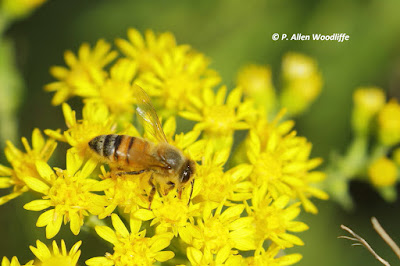Note: my apologies to viewers and commentors on this blog shortly after it was posted. I was making a minor edit, and all of a sudden the entire post disappeared! I think I have it more or less as originally posted.
Dwayne: thanks for your comment. I have been privileged to see lots of neat leps these last few days. And I, too, was slow to get going on ebird, and just recently attempted ebutterfly. Hope to see you on it in 2017.
Blake: thanks for your comment. I wonder what other lep goodies are out there?
And now, back to the post.......
******************************************************************************
I've been checking out a few prairie type patches in Lambton County and
also in Chatham-Kent. Butterflies won't be very plentiful for much
longer as the weather cools off, so with the sunny and warm days of
late, it is worthwhile to get out and see what is lingering this late in
the season.
Bickford Oak Woods Conservation Reserve, in west central Lambton, is a
hot spot. There are two areas, each of about 5 ha, that about a decade
ago were converted from soybeans to a tallgrass prairie type of
vegetation. It isn't exactly pristine by any means, but the dominance of
prairie vegetation is encouraging, and according to the leps....they
would seem to agree!
During some survey work there in 2014 and 2015, I came across a total of
32 species of butterfly. I've seen almost 20 butterfly species in the
last 3 visits, all in September, including 5 species not recorded there
in the past. Some of these new species were not unexpected, such as the Black and
Spicebush Swallowtails. Common Buckeye wasn't a total surprise, and
since it has been a good year for Common Checkered Skipper in southern
Ontario this year, it was good to add that one. A mating pair of them
was a bonus. The Variegated Fritillary is generally uncommon in
southwestern Ontario, so it was nice to get this one on the list as
well.
 |
| Black Swallowtail |
 |
| Common Buckeye |
 |
| Common Checkered Skipper |
 |
| Spicebush Swallowtail |
 |
| Variegated Fritillary |
There were lots of the more typical species as well.
A few other spots were examined, including a recently planted prairie along the
St. Clair Parkway at the Terra/CF Industries property. It had been mowed
a few weeks ago to keep down the weedy species, so it wasn't all that
exciting, but I was pleased to find a Wild Indigo Duskywing among a few
other more common ones.
A private property along Tulloch Line that I had access to was worthwhile, as it had a mix of
wildlife shrubs and about 4 ha of planted prairie. A couple of
white-tail fawns were there to greet us.
Pearl Crescents were fairly common.
Silver-spotted Skippers were plentiful.
Monarchs are migrating, and often seen nectaring on the various sunflower species that are prevalent in a prairie.
Sometimes there are several on a single plant!
 |
| Three's company?? |
Eastern-tailed Blues were fairly abundant.
 |
| Mating Eastern-tailed Blues |
A brief stop at Peer's Wetland just east of Wallaceburg did not have
many butterflies in the prairie patch while we were there. But we did
see a Common Checkered Skipper.....they are everywhere this year, it
seems.
No doubt the most abundant butterfly at any of the sites I've been to
are Cabbage Whites. And by the looks of it, more will be on the way.
Not quite as abundant but still one of the more common butterflies is the Clouded Sulphur.....
.....neck in neck with the Orange Sulphur.
Viceroys are not common at all....only one or two here and there.
Of course there are many other invertebrates using these heavily
vegetated patches. Grasshoppers are extremely abundant. Less common are
things like this rather large Chinese Mantid. I am always fascinated by
the way this species can turn its head to peer at you, and with its
protruding green and black eyes on a triangular shaped face, it reminds
me of E.T. of movie fame.
Black-and-yellow Garden spiders are abundant, and they often have
captured a grasshopper in their web. If you aren't paying attention, it
is easy to run into them.
 |
| Argiope sp |
With all of the goldenrod and asters currently in flower, pollinators
are abundant. Honey bees in particular fill the air with buzzing.
A couple of days ago I was at the wetland/prairie complex at the north
end of the Mitchell's Bay North Shore Nature trail. Among some of the
more common butterflies, I was pleased to find Fiery Skipper and my
first of the year, Little Yellow.
 |
| Fiery Skipper |
 |
| Little Yellow |
Some late season Black Swallowtail caterpillars are still around. I've
seen several in garden patches that have dill or fennel. This one was in
a nearby garden plot, and one was still developing in our garden
earlier today. It may overwinter in its pupal stage and emerge as an adult in the spring.
I've been entering some of my findings on ebutterfly, which is very
similar to ebird. One thing that I find surprising is how few Ontario
butterfly records there are submitted to that database, especially since
it seems many birders are also keen to watch for butterflies. Any
thoughts on why this is so?



























































